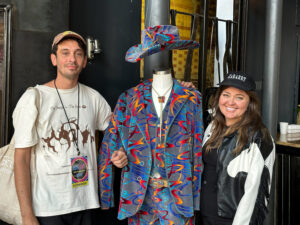New/Next “Carpet Cowboys” Interview
Written by: Christopher Llewellyn Reed | August 26th, 2023

Documentary directors Emily Mackenzie and Noah Collier just premiered their debut feature, Carpet Cowboys, at Baltimore’s inaugural New/Next Film Fest (where I reviewed it). The film examines the carpet industry in Dalton, Georgia, the “carpet capital of the world,” following a fascinating cast of characters, foremost among them designer Roderick James. I chatted with Mackenzie and Collier at the festival, and now here is that interview, edited for length and clarity.
Christopher Llewellyn Reed: How did Dalton, Georgia, become the “carpet capital of the world”?
Emily Mackenzie: So, it’s basically like a cottage-industry/evolution story. Way back when they used to make chenille bedspreads, it was kind of a hobby which women would do for their own households and then sell them on the side of the highway. This would be the north-south highway, which I think they called “the Dixie Highway.”
Noah Collier: Highway 41.

EM: And they would put these chenille bedspreads out along the highway and they would have big, beautiful designs … a lot of peacocks, and so it became known as “Peacock Alley.” And the way you make chenille is more or less the same way you make a tufted carpet: it’s thread that is put through a fabric and then you steam it and then it tightens like that and makes these little things. And so they started making them out of chicken coops and adding more and more needles for the bedspreads and eventually realized, “Oh! We can use this to make rugs, to make carpets.” And that’s how they began making carpeting.
And then, as time went on, people had a demand for carpets. And the original looms were the same width as a chicken coop because that’s what they were building the first sewing machines out of for the carpets and it just grew from there. It was just such a central place, with travel between Chattanooga and Atlanta. The industry just kept growing and growing and growing.
CLR: And do you know when the industry there really began to obtain such a dominant position?
NC: Maybe the 1940s?
EM: Don’t quote us on that as historians!
CLR: But the by the middle of the 20th century, maybe?
NC: Yeah.
CLR: Is that status now in some danger? Am I reading your film correctly? We see China as a competitor.
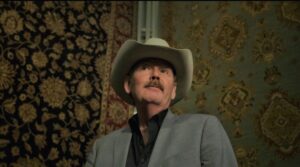
EM: I think one thing that is a big shift in Dalton is that it’s still the “carpet capital of the world” but now they say they are the “flooring capital of the world.” They’ve made a really strong pivot to also manufacture other things, namely hard surfaces, all of those composites, linoleum, or the things that look like wood but aren’t wood. All of that is now also made in Dalton. And a lot of that is because they have the infrastructure there for shipping, they have these huge mills and other electricity works. It’s all still really strong there. So, the industry continues. In fact, a lot of Chinese companies are coming to Dalton to build their mills there, to do their manufacturing in Georgia.
NC: I think it’s important to note, at least anecdotally from what we’ve heard in town, that there’s more money coming out of Dalton than there ever has been. It’s not declining in that way. It’s just that the industry has consolidated and it’s now a number of huge corporations instead of dozens and dozens of smaller companies, as it used to be.
CLR: Understood. That much was clear. So, what made you choose your particular subjects for the film? How did you find them and how did you narrow it down to them?
NC: We initially came into the project with an obsession with carpet design and so were searching online for the carpet designers and the brains behind this kind of psychedelia that exists all over our commercial spaces. And we found Roderick James online. He had this completely overwhelming GeoCities page, and Emily found his Facebook profile, which had this series of heroic photos of him riding mules through raging rivers … (laughs) … and we just felt like he would be a good steward for us through the industry. And when we met him, he was sitting in complete silhouette with his partner, Jon, and they were both wearing matching cowboy hats, and they turned to us and … (turns to Emily) … what did he say? …
EM: “I’ve been waiting for this call my whole life. You found gold.” And we were like, “Alright! Let’s go!” (they both laugh)
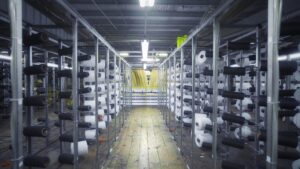
CLR: That’s wonderful: you made his day, his life, with this whole movie. It seems as if you saw Roderick as this kind of avatar of these changes wrought on the industry by late-stage capitalism and consolidation. Was it clear in the beginning that that’s what he was going to become?
NC: We didn’t come into it with a prefabricated narrative. We were really open to any twists and turns in Rod’s life. And there were a lot of things that were sort of misdirections in his life. At one point, he was going to do a 35-person country-music tour to China that we thought was going to be the direction of the film. And then that fell apart. Things came and went so rapidly and we just tried to follow it. And I think that we mainly started following Rod because he was the person in this changing landscape who wasn’t looking back but was trying to forge some sort of new way through the economy.
CLR: How about some of the more incidental characters? Did you have a larger cast to begin with and then just settled on those?
EM: I don’t think so. Did we lose …? I think we lost one scene.
NC: (laughs) No one got cut.
EM: No one was cut, yeah. Basically, we had a few people we met on the first trip, and that’s most of the people who are in the film: the father-son duo, the wholesalers, we met them our first day in Dalton. Roderick, Jon, Harry—the man with the rock faces—is a friend of a friend. But that’s kind of it. We just kept coming back to them, saying, “Can we film more?”
CLR: How long was your total shoot?
EM: We started in December 2017. We both work a lot, on other things, to pay the bills, and so, between our other gigs we would go for 3 to 6 days to Dalton. It was a bunch of short shoots. (turns to Noah) What did we do? We did, like, 9 shoots over the course of 4 to 5 years?
NC: Yeah. I think that’s about right. And then one longer shoot in the Philippines.

CLR: For how long were you in the Philippines? It seems as if there are two different timelines in the Philippines, but maybe you just edited it that way.
NC: Everything in Rod’s life moved so quickly that it creates these bizarre timelines in the film. Within a week of being with Roderick, he’s fully envisioned an idea all the way through and then changed his mind. (laughs) And a lot of the arcs are confusing in real life to make sense of, so … I think the shoot in the Philippines was maybe 3 weeks total, but it was just one single shoot.
CLR: So when you have that gap of “2 years later,” and then we return to the Philippines, that part isn’t necessary later?
NC: It was “2 years later” in Dalton. We were tracing that timeline.
CLR: And was that gap due to Covid?
EM: Largely, yes. We were in the Philippines in January and February of 2020, and we got there wearing masks because of a volcanic eruption that was happening, and we left wearing masks because there was this whole global pandemic thing. So, yes, we had to stop down, and then when we were able to come back to town, it was a couple years later.
CLR: How is Roderick doing now? Any luck with China or with his ventures in the Philippines?
EM: He’s still in the Philippines. We watched the film with him a couple of weeks ago and it went really well. He laughed! He cried! It was fun to watch with him. He’s kind of in the same spot as he was. He and Rosario have opened … it’s not quite a Western-themed bar, but it’s like a beach bar/restaurant space that has music, so it’s kind of venturing towards one of his agendas. But he’s still freelance designing, still living in the Philippines and still singing a lot of songs.
NC: And he’s still making music and we are very excited to release the theme song and music video that he produced for our film after watching it … within three days. (laughs)
EM: Yeah! It was, like, the next day! He sent us a reworked version of “Rhinestone Cowboy”—now it’s “Carpet Cowboys”—and redeveloped the lyrics and did his own instrumentation and it’s very sweet. Very good! I like it.
NC: It’s very moving.
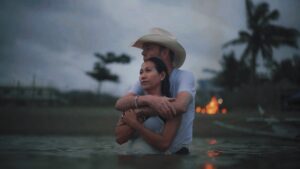
CLR: I can’t wait to hear the song and to see the video! It sounds amazing. So, Roderick makes a comment in the film—kind of a throwaway comment—that he’s “through with Western women.” After watching the film, I did a Google search. I was just curious: is this a common thing among men of a certain age?
EM: Oh, boy.
CLR: (laughs) And there are plenty of Reddit threads, of course. It seems like it’s a topic that could be rich for investigating in a film.
EM: Sure!
CLR: It just seems like it’s a particular kind of person who thinks that way. Could be a great film topic. What do you think?
EM: Maybe. I don’t really want to live inside of that brain space if I don’t have to. There are no questions I have about it that I want to spend time getting answered. Does that make sense? I don’t mean that in a hostile way. I think I understand how a lot of that works. I have stories of extended family that are like, “Oh, where did that one uncle go?” And it makes sense. There are interesting ways to talk about it. But no, I don’t think I want to make a film about aging white men going to other places to find young brides. Which is not what Roderick did, for the record. I think it’s really important to note that. Rosario is his age. She has her own job.
NC: She runs multiple businesses. She’s financially independent. It was reassuring to us when we met her. It is actually a loving relationship.
CLR: He did not find a much younger person to partner with, indeed.
EM: Yeah, the power dynamic that is prevalent in those other relationships is not what theirs is about.
CLR: If anything, it seems like it could be more on her side, since they’re in her country.
NC: Yeah! We didn’t know what to make of it, initially. We had been filming with Rod for years, and when he decided to move to the Philippines, we were nervous about what that potentially would look like. And then we were actually very reassured when we met her. Rosario is very powerful in that relationship and it was fun to see Rod become vulnerable and put on flip-flops for the first time in 25 years to go to the beach with her. (laughs)
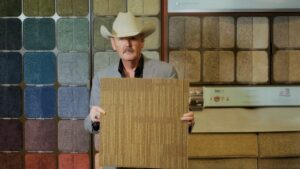
CLR: He still has his cowboy hat, though!
EM: Always.
CLR: I really dig your score, by Kara-Lis Coverdale, and then your sound design is by former Baltimorean Matt Davies. What was it like working with both of them?
EM: Amazing! I love them both so much! Kara-Lis is a wild, wonderful creative genius. So she was off in sort of a swamp-woods studio in Canada, where she lives, and would ask us these incredible, esoteric questions, such as, “For this scene, describe what part of the body it is and what the color is.” And I was like, “Huh?” And then out of these many abstractions she would come back with the perfect score. I don’t know, it was just this incredible conversation that led to really beautiful music.
CLR: Did she compose based solely on your descriptions or did she see some of the images in the film?
EM: She saw the film, and also a lot of the temp music we used when we were editing was her work, and so we were able to say, “We really like this thing that you did with that,” and so … I think through that she, I would assume, got a sense of what we liked that came from her, and we just loved her music so much. We told her, “We trust you a lot and want you to add your vision and your take on it.”
NC: I think she was really analytical about what the score was doing at what moment, and we would often explain to her, through these bizarre exercises … (laughs) … what color and what body part we were starting with and then she would come back a week later and walk us through the 5 levels of removal that she had gotten to from our original conversation, step by step, and why she made each change. It’s incredibly calculated.
CLR: And then, when did Matt Davies step in with the sound design?
EM: At the end. We knew he was going to do the sound design, long before we actually ended up working with him. He saw a couple cuts along the way. And then it was over this past winter that we did it. We spent 8 hours going through it scene by scene and then he did a big pass. And then we went out to L.A. for the better part of a week and sat on the big soundstage with him.

And he was another person who I felt really understood the film. And so we trusted him a lot with his comprehension of the characters, and what we were trying to do, to then use his art and his skills to make it beautiful. Because I wouldn’t know. “OK, let’s do Foley of this to bring out this feeling.” He’s an expert at that. It’s his profession, so we leaned on him. He did a lot of good bird design.
NC: Yeah, Matt Davies is obsessed with birding. He did all this research on birds of the area and then brought these bird calls into it that are really low in the mix. (laughs) And so, embedded in the film is Matt Davies’ birding profession.
EM: Yeah, his amateur ornithology.
CLR: That’s so fascinating. So, you, Noah, shot the film. And it’s beautifully shot. Could you please describe your approach, and also what camera, or cameras, did you shoot on?
NC: We kind of shot with the equipment that Emily and I just own, and so it was shifting and kind of haphazard, but we were able to put it together. We shot with mostly Sony cameras and Zeiss prime lenses. I think that my approach to filming things is like chasing a very uncontrollable situation and then trying to create some sort of point of view within that.
CLR: Well, I think you do a great job! And I think you both did a great job with the film. Thank you so much for talking to me.
EM: Yeah!
NC: Thank you!
